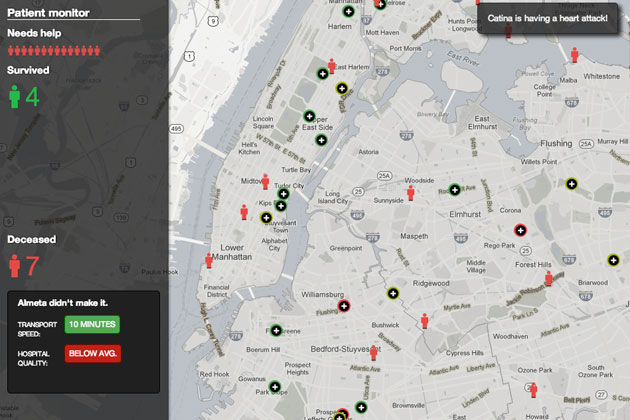Thanks to an influx of new, cheap tools and growing diversity among game developers, the video game industry is experiencing a period of significant change, especially in the indie scene. Leveraging one of the medium’s primary affordances — empathy-building — games like Cart Life, Depression Quest, and Papers, Please offer us a roadmap for how journalism can use games to tell even more compelling stories. In Cart Life, you assume the role of a street vendor, living and struggling through the monotony of menial labor — and the repetitive, tiresome gameplay reflects that:
In Depression Quest, a choose-your-adventure style game, you assume the role of someone living with depression. Just like any interactive fiction game, you make choices to advance the story, but there’s one catch: to tangibly convey the emotional experience of depression, the game shows you the entire range of possible actions, but some of those options are crossed out depending on your current happiness level. The frustration a player experiences in playing Depression Quest can tell them a lot more than a simple medical description of depression.

“Dystopian document thriller” Papers, Please is a game in which you play as an immigration inspector at the border checkpoint of fictional country Arstotzka. While the gameplay is relatively basic (reviewing and stamping papers), the game effectively portrays a volatile political situation and evokes a sense of emotional toll within the player. All these affordances seem to suggest that the video game medium has the opportunity to enable new modes of journalism.
Newsrooms haven’t missed out on this — the most-trafficked New York Times story of last year was How Y’all, Youse and You Guys Talk, a quiz (based on real research) that asks you about what words and pronunciations you use for different things in order to identify your dialect. Mother Jones has open sourced a library that turns Google Spreadsheets into simple news quiz games. Nobody’s Facebook feed is free from the reach of the BuzzFeed quiz, a format that they continue to iterate upon.

In some ways, the newsgame seems to be the natural extension of the interactive graphic. They can be used to distill complex concepts, like BusinessWeek’s bitcoin mining minigame, what I like to think of as a game version of the explainer. Moreover, newsgames can be used to viscerally communicate real-world data, as can be seen in ProPublica’s HeartSaver, a game in which you must rush the heart attack victims of New York to nearby hospitals. Now we’re starting to get into the territory of conveying emotional experience. Similarly, The New York Times’ Gauging Your Distraction puts you behind the wheel of a car, in which you must juggle the tasks of switching lanes and texting.

While I’m still in the exploratory phase of my project, my general idea is to create some sort of newsgame design tool or toolkit to help newsrooms create games for journalism, with the hope of eliminating some of the technical hurdles that have prevented all but the most code-savvy newsrooms from dabbling in the field. My major concern with developing it as a tool is the balancing act between procedural generation/abstraction and the hand-crafted design elements that are so core to an effective game experience.
Highly procedural approaches like The Cartoonist are great in terms of lowering the technical barriers to entry for newsrooms, but the resulting games (at least the ones I have been able to read about or watch online) seem pretty reductive, as the engine generates games based on user-defined relationships and verbs. Another approach would be to anticipate a few key narrative frames and having those directly translate into corresponding gameplay elements. With any of these approaches, repetitiveness between the resulting games seems to be a major problem — even if the theming/artwork has been changed, players will easily recognize that they are playing the same game.
With these concerns in mind, it seems like I will focus on a more generalized tool — perhaps repurposing an existing engine like Twine specifically for the newsroom, or creating tools for playful interactive experiences (but not full “games” per se) like quizzes. The project might even take the form of a design toolkit to help newsrooms through the process of conceptualizing a newsgame. I will be talking to the MIT Game Lab and other game developers to further define the scope of the project; it will also be important to get feedback from newsrooms looking to develop games and what sorts of stories they see coming out of this. Finally, I welcome any suggestions and feedback from all of you in terms of where to take this project.


